As part of the Game Design course taught by Jesse Schell at Carnegie Mellons Entertainment Technology Center, we were required to create whatever game experience we wished. The one requirement we had for this experience was that it was to be excellent! So I created Dominate, a tablet top strategy game!

In addition to creating the experience we prepared a marketing and rule sheet, as well as a written record of our iterative playtest driven process. The following is materials from my playtest notes.
Playtest Notes
Playtest 1

- Date: March 29th 2017
- Purpose: Playtesting initial concept
- Playtesters:
- Me
- Time: 20 minutes
- Playtester Comments:
- A significant number of broken rules
- Two resources for construction, sheep and wood were unnecessary
- Need a method of counting the different resources, can’t keep track of it mentally
- How do I know when I won?
- Observations:
- Playtesters had trouble counting tokens
- Giving players the choice of resource location made resource placement polarized and clumped
- Since no restrictions of village placement players would build lots of villages around themselves making the game drag out longer
Revisions
| # | Description | Purpose |
|---|---|---|
| 1 | Removed wood | Was unnecessary |
| 2 | Bought chips | Made counting easier |
| 3 | Made rule about connecting villages | Limit the construction of villages and temples to speed up the game |
| 4 | Gave temples life | Made possible a lose condition (all enemy temples hp goes to zero) |
| 5 | Wrote up rule set | Needed a document to playtest rules with |
Playtest 2
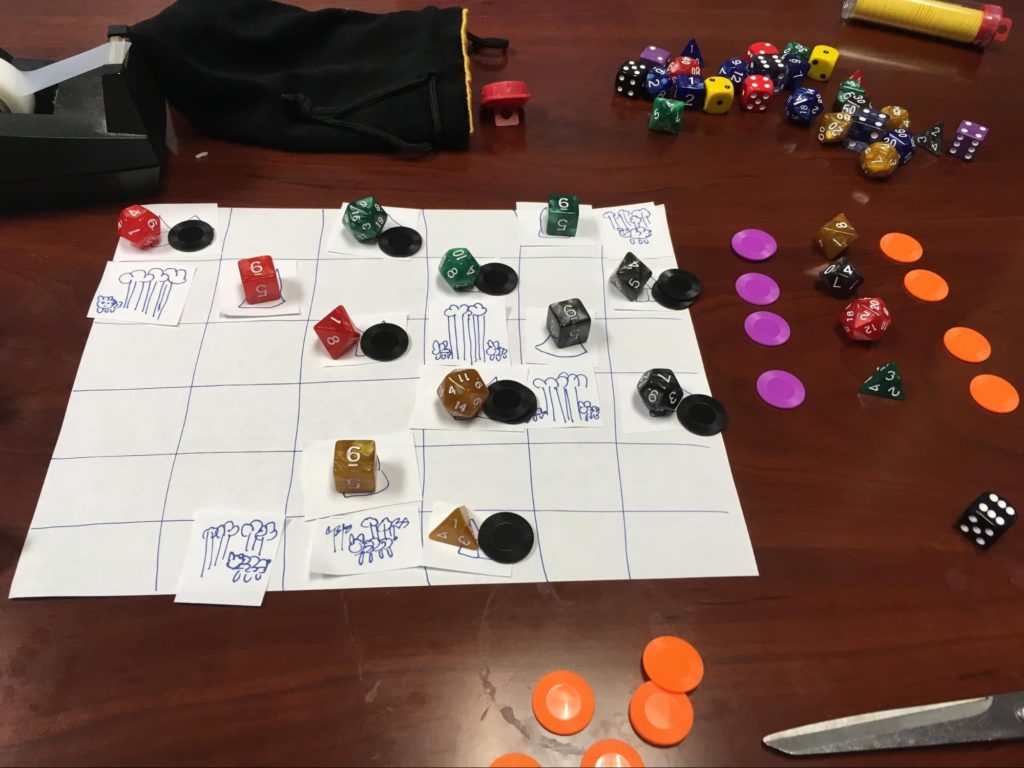
- Date: March 30th 2017
- Purpose: First playtest with largely functioning game
- Playtesters:
- Me
- Male – 21
- Male – 23
- Time: 40 minutes
- Playtester Comments:
- Fireball need chance on hit, I didn’t like knowing I would lose for sure
- Who casts first should be based on a dice roll, again I didn’t liked knowing I would lose for sure
- The rules for village placement are confusing
- Found resource collection rate difficult to count
- Liked the strategic element in fireballing then converting enemy villages
- Observations:
- Players had a good time
- Players wasted a lot of time counting resources
- Found an issue when a player placed their temple in a certain pattern, they became blocked from building
- Both my playtesters were programmers
Revisions
| # | Description | Purpose |
|---|---|---|
| 1 | Allowed world to wrap around itself | Avoid issue of limitation of three building connections per building |
| 2 | Fixed in rule sheet to clarify village placement | Clarification based on request |
| 3 | Added initiative system to allow the spell phase not be a guaranteed thing | Stop the feeling that you were guaranteed to lose |
| 4 | Add a conversion of resources to belief 2:1 | People seemed to enjoy the spell phase more than the build phase so I wanted to charge up the spell phase. Also it was one method of increasing the utility of resources making investing in resource growth more useful. |
Playtest 3
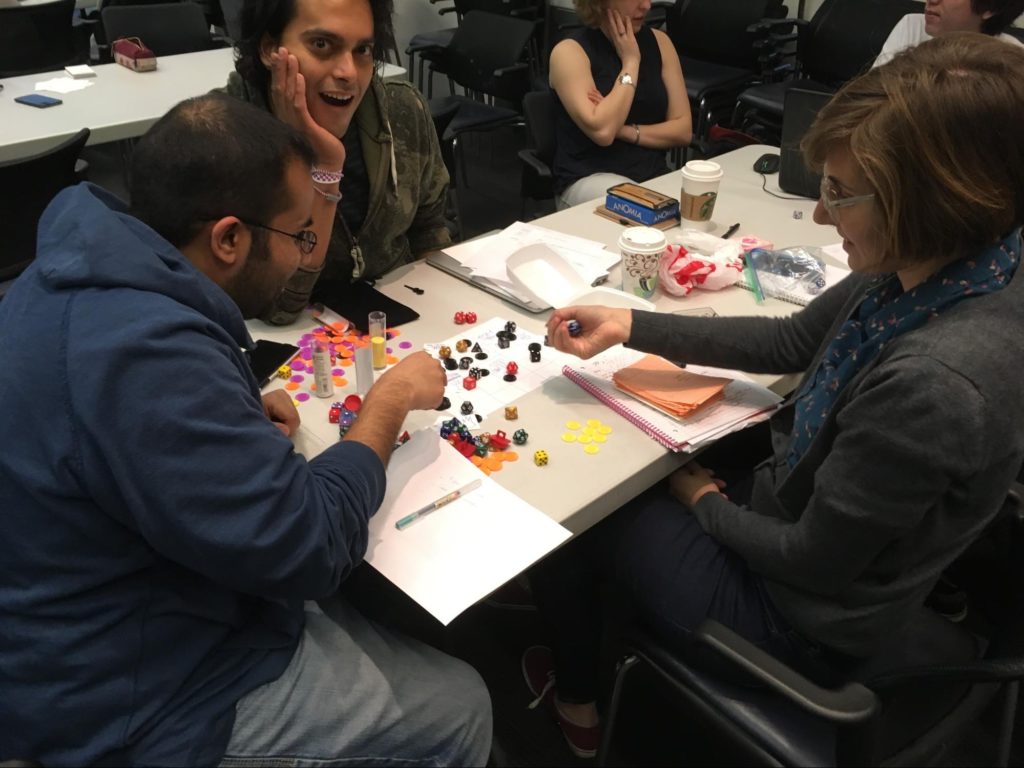
- Date: March 30th 2017
- Purpose: First iteration of rule sheet, introduction of game to more ‘casual players’
- Playtesters:
- Me
- Male – 28
- Female – 30
- Time: 45 minutes
- Playtester Comments:
- Make the game board bigger!
- Color code the villages!
- Board is so cluttered, can’t see anything!
- Don’t need initiative rolls every time, just do contest rolls on build if wanting to build in the same spot (everyone declares where they are planning to build then builds)
- Clarify rules
- Observations:
- Playtesters got bored waiting for their turn
- Playtesters didn’t read the rules at all
- Playtesters had great difficulty counting belief and resources
- Playtesters found the world wrap rule super hard to visualize
- Both my playtesters were more artistic individuals, casual game players – from the previous playtest it seems that my game is more suited to strategy game fans
- Playtesters converted all their resources in belief as they found that part most fun
- Playtester though the strategy of high belief would work. but lost because had no base of resources to sustain that burst of belief
Revisions
| # | Description | Purpose |
|---|---|---|
| 1 | Made game board bigger | Reduce clutter |
| 2 | Made color coded tiles and villages | Made one's own villages easier to see |
| 3 | Introduced contest rolls on build | Way to allow free for all building while allowing to resolve two players wanting to build on the same place |
| 4 | Touched up rule page | Added more pictures in case people didn't want to read |
Playtest 4
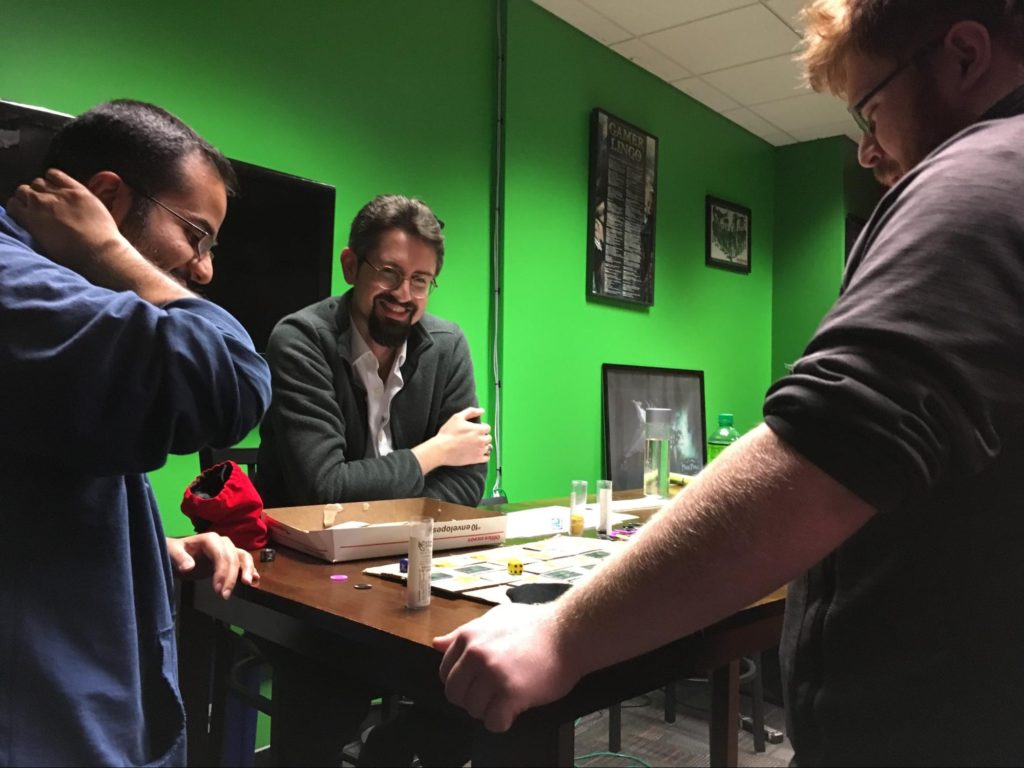
- Date: 5th April 2017
- Purpose: Second iteration of rule sheet and 1v1v1 setting
- Playtesters:
- Me
- Male – 26
- Male – 30+
- Time:
- 10 minutes to understand rules
- 40 minutes to play game
- Playtester Comments:
- Include pictures of tiles on instructions
- So what is the victory condition?
- Mention influence earlier
- Use the word adjacent, its more clear
- Clarify construction rules, they are not clear
- Mention that villages at 1 development level cannot be destroyed
- Typo on spells, town not village
- Observations:
- Watching these playtesters reading the rules showed that I needed to change the information order to make the document easier to process
- Playtesters were confused that they needed to select separate colors
- Playtesters placed tiles on top of each other which I needed to verbally clarify
- Playtesters found the phrasing of various parts of the rules confusing, and had to jump back and forward in the rule book to understand the rules
- Players found the overlap rule confusing
- Players found counting the resources wasnt too bad
- Player suggested using higher value counters to make collection of resources faster
- Players suggested a counting tool to keep track of how much you need to collect
- Players suggested bidding resources to win the spell phase
- Players suggested building should not be simultaneous but instead be one after another like before
- Players suggested a thematic change to lighting bolt
- Player had difficulty understanding the rules at first but then got into the game
- Players felt the counting of belief and resources was most tedious
Revisions
| # | Description | Purpose |
|---|---|---|
| 1 | Reduce cost of fireball to 1 but introduced a probability of it missing (intention is to create more tension when attacking) | Create a balanced fireball spell with an element of chance |
| 2 | Added image of village and temple to rule set | Wanted a visual indicator of what was what for easier understanding |
| 3 | Made a resource/belief tracker for easier counting | Wanted players to focus on the game rather than counting chips |
| 4 | Added 2-1 conversion to rule sheet | Improve the rulesheet |
| 5 | Made variety of fixes to rule sheet e.g reordered sections – clarified victory conditions – made explicit mention that tiles dont stack – clarified construction rules – explicitly said players are assigned colors | Improve the rulesheet |
Playtest 5
- Date: 8th April 2017
- Purpose: Third iteration of rule sheet and 1v1v1 setting
- Playtesters:
- Me
- Male 32
- Male 26
- Time:
- 10 minutes to understand the rules
- 1 hr 20 minutes to play game
- Playtester Comments:
- Playtester complained that reading the rules felt like studying
- Very interesting moment when players said no need for chips use the income tracker to keep a track of how much you have instead
- Playtesters mentioned income tracker could use a zero
- Playtesters suggested having some visual indicator for turn order
- Players wanted the resource and belief tokens on the income tracker to be more obvious
- Playtesters found the income tracker awkward to use, and instead wanted more numbers on it instead of having to do arithmetic
- Playtesters wanted a more efficient way of removing and adding villages to the board, and suggested making color coded physical representations of the village which could be placed and removed from the board
- Playtesters suggested carefully considering how to manage the player who would lose the game early – either give them incentives to stay after losing, design it so they can continue and have an incentive to stay, or accelerate the game to end quickly
- Playtesters suggested trying 1v1 or 2v2 game format.
- Observations:
- First time I explained as little as possible and had playtesters read the rules and play, had to explain income tracker.
- Playtesters understood how to generate the board, and do the initial game setup
- Had to explain the income tracker
- I needed to explain both how to represent development levels, how to use the income tracker, and using d6 to represent hp on the temple
- Players never used the offering mechanic
- With three playtesters the maximum amount of belief/resources reached around 15-16
- What happened was a Mexican standoff moment where each player had direct access to attack the other players temple, and it turns out that based on chance of spell phase the weakest player actually won the game because one player destroyed one other player and the weakest won the spell phase of the next turn and killed the other player before they could retaliate
Revisions
| # | Description | Purpose |
|---|---|---|
| 1 | Changed the income tracker to the warchest a tool for keeping account of how much resource and belief a player has | Completely eliminate the need to use chips for keeping track of a player's belief and resources |
| 2 | Kept the offering mechanic | Wanted to test how it would affect a game when used properly and it was designed reduce the power of the spell phase and also mess with the power that a guarantee of casting spells first gave |
| 3 | Changed the income tracker to warchest also added a zero on it | Completely removed the need to use chips to represent the amount of resources you had allowing players to focus even more on the core experience |
Playtest 6
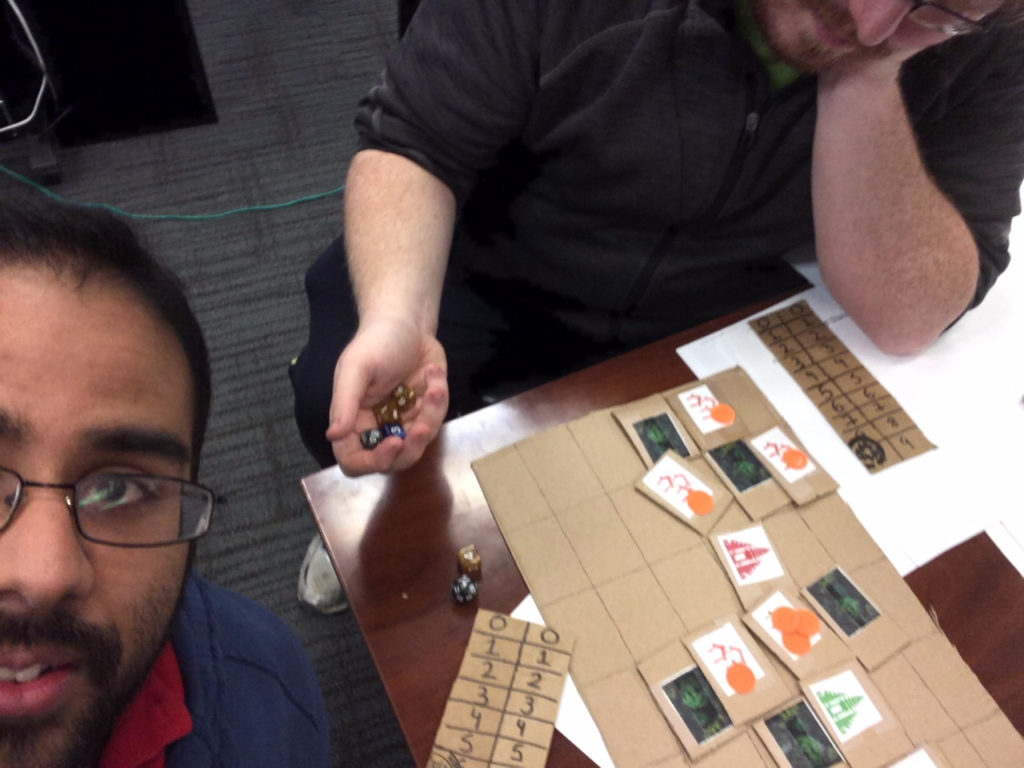
- Date: 9th April 2017
- Purpose: Wanted to test what 1v1 was like
- Playtesters:
- Me
- Male – 21
- Time: 25 minutes
- Playtester Comments:
- Playtester got upset and felt cheated by the game because didn’t fully understand the rule of only allowed to connect to three adjacent buildings
- Observations:
- Playtest was short, and other player lost very quickly, playtester wasn’t happy at all, felt cheated by the game
- Problem was they were in a situation where they could not build anything anywhere – I think a solution that would be in the 1v1 game mode give players two temples rather than one to add more skill to it
- Used the offering mechanic to spell first
Revisions
| # | Description | Purpose |
|---|---|---|
| 1 | Made three game modes – 1v1v1 – 2v2 – two players with two temples each – 1v1 – each player has two temples | Avoid the disastrous playtest happening again with giving a single player two temples |
Playtest 7
- Date: 9th April 2017
- Purpose: Wanted to test out what the 1v1 with two temples was like
- Playtesters:
- Me
- Time: 33 minutes
- Observations:
- The dynamic was certainly different, two allied temples were placed back to back
- Other two were on sides of map
- What ended up happening was that middle two gained lots of resources and that built up over time, eventually the aggressive village tactic was overcome by resource snowballing and the central allied players eventually won, and the two outer players forfeited before the end of the game
- Found that placing resource chips (chips that represent the resource income of a tile) made counting of resources so much faster, will do it in future playtests
Revisions
| # | Description | Purpose |
|---|---|---|
| 1 | Added resource tokens onto village and temple tiles | Making counting of resource income much faster |
Playtest 8
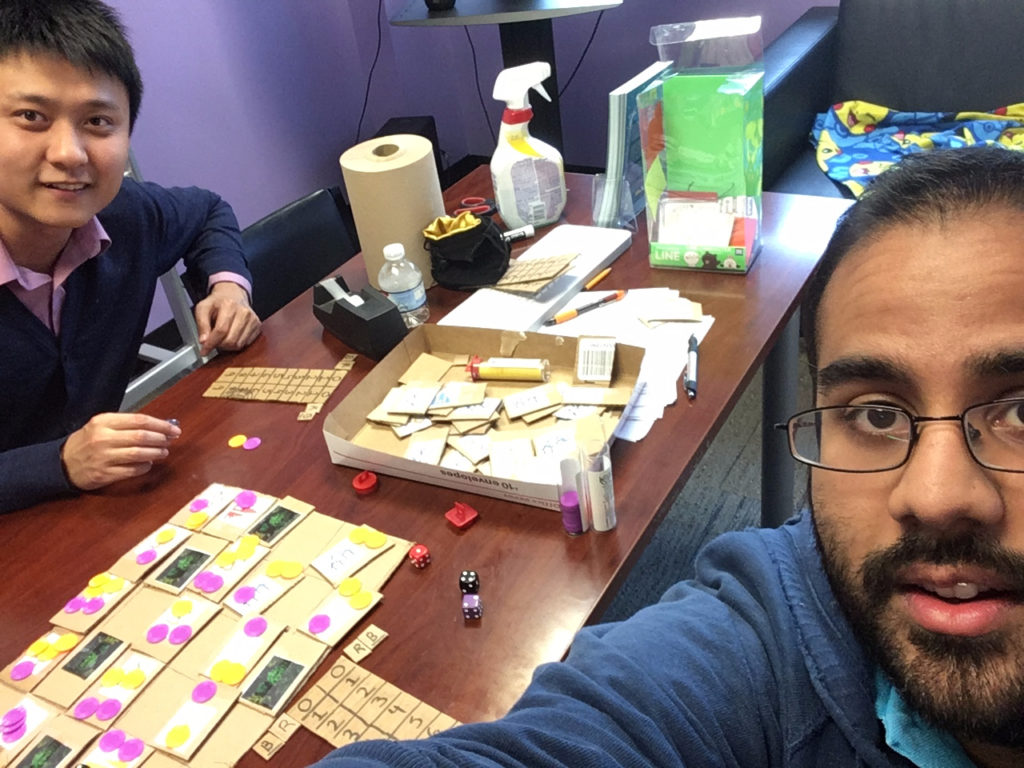
- Date: 10th April 2017
- Playtesters:
- Me
- Male – 24
- Time: 42 minutes
- Playtester Comments:
- Initially I was doing well then the playtester converted a critical village and I lost
- Playtester liked the idea of converting resource to belief
- Told me that playing required multidimensional thinking, resource gain, blocking, and long term growth
- Resources became so important because of offering system
- Required finding critical villages and capturing them, anticipating your enemies offering
- Playtester commented that warchest system was good, but they didn’t mind the old system of counting chips one by one
- Playtester appreciated new method of displaying village and resources on map
- Observations:
- Found it hard to find resource tiles since tiles were in a pile
Revision
| # | Description | Purpose |
|---|---|---|
| 1 | Playtester found better way of arranging belief and resource tokens on warchest. Keep it by the side as to not obstruct the numbers. Will update that in the rule set | Improve warchest by having tokens not obscure the warchest |
| 2 | Made a box with compartments to make it much easier to find the piece you needed | Reduce the hassle in finding game pieces |
| 3 | Added the resource and belief token representations to the rules | Speed up the process of counting resources and belief |
Playtest 9
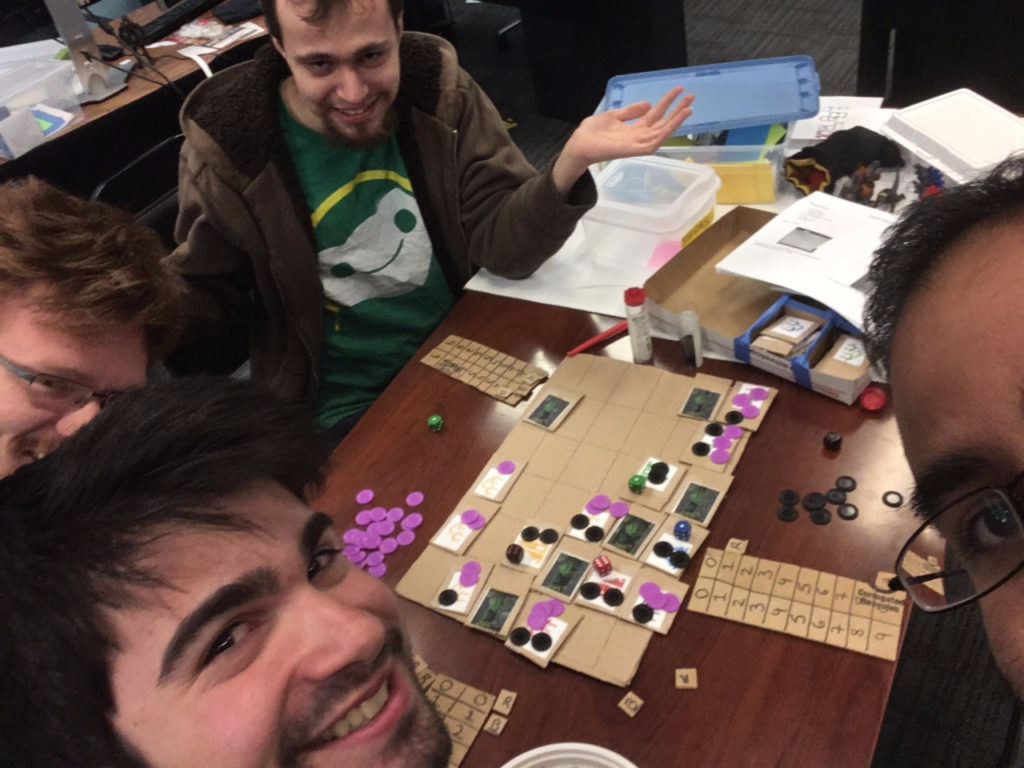
- Date: 10th April 2017
- Playtesters:
- Me
- Male – 21
- Male – 21
- Male – 22
- Time: 40 minutes
- Playtester Comments:
- Asked if resources were generic
- Couldnt find use for belief
- Confused about building only within area of influence
- Found village upgrade table super confusing they thought it cost one to upgrade to level 2
- Got confused by a line that said build first cast spell last
- Highly disliked the whole 3 adjacent village thing
- 6×6 feels small for 4 players
- Game suffers from same problem as RISK where one player clearly snowballs to victory
- Feels like you know who is going to win from the start based on the position
- Playtesters said consider a large map and multiple temples
- Playtesters suggested giving temples some resistance to fireballs
- Observations:
- Read the rules in 6 minutes – skimmed it
- Allied players placed their temple in a resource rich but locationally disadvantaged position, and were unable to get lucky enough to break out of their bad positioning and so lost the game
- Playtesters did not know the rule of adjacent first and so placed thinking they could place anywhere and that they said messed up the game for them
Revision
| # | Description | Purpose |
|---|---|---|
| 1 | Remove the rule of adjacent to three | Players were not liking this rule and often players including myself forgot about keeping to this rule |
| 2 | Change the phrase resource cost to construction cost and phrasing around construction and upgrade of villages | To clarify this |
| 3 | Added new rule for temple damage | Made temples resistant to fireballs to reduce likelihood of player losing in one turn |
| 4 | Made changes to rule set based on confusions from playtest | Improve the ruleset |
Playtest 10
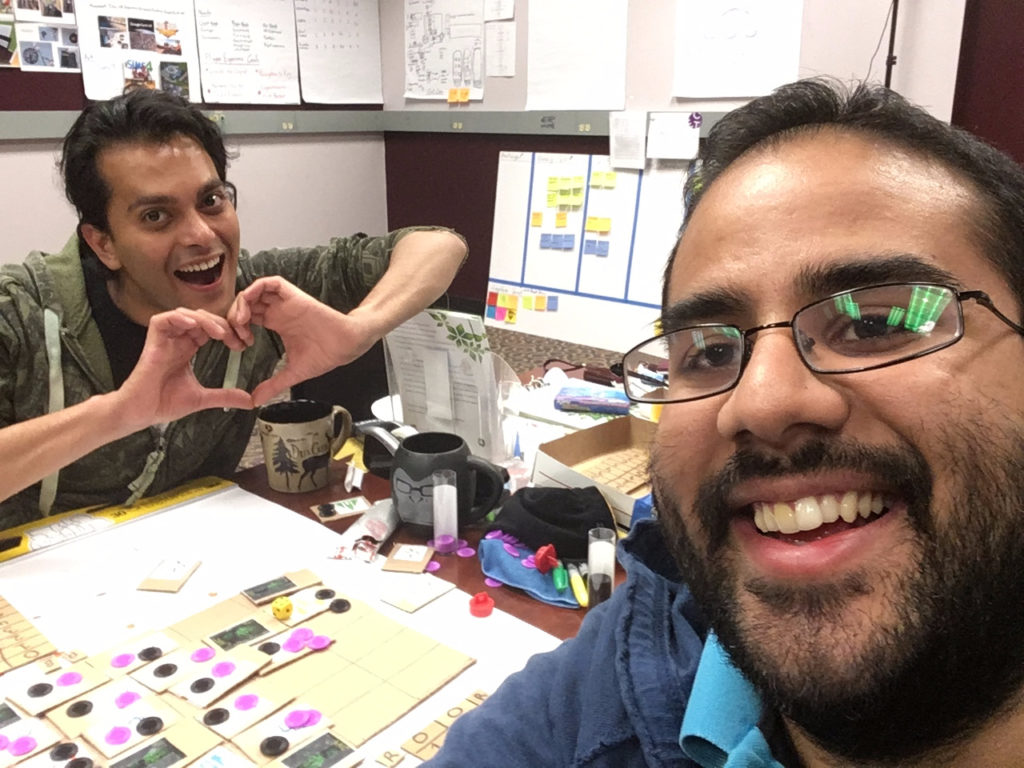
- Date: 11th April 2017
- Playtesters:
- Me
- Male – 28
- Time: 42 minutes
- Playtester Comments:
- Destroyed temple should become empty
- Board still needs to be bigger, still feels cluttered but is improved from before
- Fun game, liked the warchest system
- Moving around map, places hard to reach
- Didn’t want to place 1 belief villages as it was suboptimal
- Inert villages seem weird in 1v1 didnt think to convert own because it felt you already owned it
- I would play again
- Real time strategy board game
- Wished there was another dimension to movement
- Observations:
- Player went crazy in converting to belief to try and take me out quickly
- I invested in building up resources and eventually snowballed to victory
Revisions
| # | Description | Purpose |
|---|---|---|
| 1 | When a temple is destroyed is becomes empty | More sensical outcome and reward for the player who destroyed the temple |
| 2 | Clarified offering rules in rule sheet | Improve the rule sheet |
What Went Right
- Warchest system was a marked improvement over the old system of counting chips. The warchest cleared up the playspace and created an easy way for players to keep track of their resources without fussing around with chips. This allowed them to focus on the game.
- New method for representing income and belief made collecting resources at the start of the turn much easier, before a significant amount of time was wasted counting, and this was a marked improvement.
- Adding dice rolls to attacking heightened the tension in the game and had a positive effect on gameplay.
- Once players got over learning the rules they had generally positive feedback about the experience, particularly that throughout the game players had the option of several interesting choices.
- Adding the resource to belief conversion rule was highly appreciated. By doing so it created a good reason to invest in growing one’s village network so that a player had more resources to convert to belief. Now players would avoid wasting placing villages that weren’t connected to a resource. This helped address the problem I had seen in my first playtest of arbitrarily building villages.
- The way the game was designed allowed it to be very easily scalable in terms of grid size, number of players, temples per player, resource tiles per column. This design supported a wide variety of game modes 1v1/2v2 which felt distinct, and so the game was more accommodating to different numbers of players.
- Procedural generation of the board helped make the board experience fresh each time, increasing replayability.
What Went Wrong
- Playtesters didn’t spend much time reading the rules, and so made suboptimal choices in the game and got upset, and felt cheated by the game. What was particularly bad was placement of temples and villages. If placed incorrectly could mean the game was lost if players didn’t get lucky with die rolls.
- As one playtester pointed out my game suffers from the problem in RISK where one player will snowball to victory and this is apparent. This caused forfeiting to occur multiple times to save time because the odds were clearly stacked against the player. RISK attempted to address this problem with country cards that gave bonus armies, perhaps something equivalent would help my game.
- Procedural generation of the board acted as a double edged blade. If in the case the board was generated in a manner that made blocking of a players progress easy, new players felt upset and cheated (in tandem with point 1)
